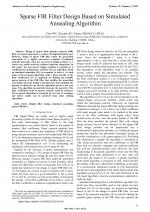| 1/2015 - 3 |
Sparse FIR Filter Design Based on Simulated Annealing AlgorithmWU, C. |
| View the paper record and citations in |
| Click to see author's profile in |
| Download PDF |
Author keywords
digital filter design, simulated annealing, sparse FIR filter
References keywords
design(12), signal(10), processing(10), filters(10), systems(8), sparse(8), response(7), filter(7), circuits(7), simulated(6)
Blue keywords are present in both the references section and the paper title.
About this article
Date of Publication: 2015-02-28
Volume 15, Issue 1, Year 2015, On page(s): 17 - 22
ISSN: 1582-7445, e-ISSN: 1844-7600
Digital Object Identifier: 10.4316/AECE.2015.01003
Web of Science Accession Number: 000352158600003
SCOPUS ID: 84924766096
Abstract
Design of sparse finite impulse response (FIR) filter is of great importance to reduce the implementation cost. However, design of sparse FIR filter under the prescribed constraints is a highly non-convex problem. Traditional methods generally relax the non-convex design problem to a convex one, which leads the obtained solutions suboptimal. In this paper, the non-convex design problem is modeled as a combinatorial optimization problem and an algorithm based on simulated annealing (SA) is presented to solve it. At each stage of the proposed algorithm, with a fixed sparsity of the filter coefficients, SA is employed for finding the possible sparse pattern of the FIR filter that satisfies the prescribed constraints. Once the design constraints have been satisfied, the sparsity is added by one and the algorithm moves to the next stage. The algorithm successively increases the sparsity of the filter coefficients until no sparser solution could be obtained. The proposed algorithm is evaluated by two sets of examples, and better results can be achieved than other existing algorithms. |
| References | | | Cited By |
Web of Science® Times Cited: 4 [View]
View record in Web of Science® [View]
View Related Records® [View]
Updated 3 days, 6 hours ago
SCOPUS® Times Cited: 6
View record in SCOPUS® [Free preview]
View citations in SCOPUS® [Free preview]
[1] Low complexity multiobjective finite impulse response filter design using Salp swarm algorithm and its improved version, Srivastava, Savita, Dwivedi, Atul Kumar, Nagaria, Deepak, International Journal of Numerical Modelling: Electronic Networks, Devices and Fields, ISSN 0894-3370, Issue 6, Volume 34, 2021.
Digital Object Identifier: 10.1002/jnm.2914 [CrossRef]
[2] Silicon on Insulator C-VTFET Based Design of low Complexity Sparse Quadrature Mirror Filter Using Differential Search Algorithm, Singh, Hitendra, Dwivedi, Atul Kumar, Nagaria, Deepak, Silicon, ISSN 1876-990X, Issue 17, Volume 14, 2022.
Digital Object Identifier: 10.1007/s12633-022-01858-6 [CrossRef]
[3] FIR digital filter design based on improved artificial bee colony algorithm, Lian, Lian, Tian, Zhongda, Soft Computing, ISSN 1432-7643, Issue 24, Volume 26, 2022.
Digital Object Identifier: 10.1007/s00500-022-07506-w [CrossRef]
[4] Finite Impulse Response Filter Design Using Fuzzy Logic-Based Diversity-Controlled Self-Adaptive Differential Evolution, Mohaideen Abdul Kadhar, K., Rengarajan, S., Tamilselvi, S., Karuppiah, N., Balachandran, Praveen Kumar, Thamilmaran, A., Dhanamjayulu, C., Khan, Baseem, Du, Sheng, International Transactions on Electrical Energy Systems, ISSN 2050-7038, Issue , 2023.
Digital Object Identifier: 10.1155/2023/1572996 [CrossRef]
Disclaimer: All information displayed above was retrieved by using remote connections to respective databases. For the best user experience, we update all data by using background processes, and use caches in order to reduce the load on the servers we retrieve the information from. As we have no control on the availability of the database servers and sometimes the Internet connectivity may be affected, we do not guarantee the information is correct or complete. For the most accurate data, please always consult the database sites directly. Some external links require authentication or an institutional subscription.
Web of Science® is a registered trademark of Clarivate Analytics, Scopus® is a registered trademark of Elsevier B.V., other product names, company names, brand names, trademarks and logos are the property of their respective owners.
Faculty of Electrical Engineering and Computer Science
Stefan cel Mare University of Suceava, Romania
All rights reserved: Advances in Electrical and Computer Engineering is a registered trademark of the Stefan cel Mare University of Suceava. No part of this publication may be reproduced, stored in a retrieval system, photocopied, recorded or archived, without the written permission from the Editor. When authors submit their papers for publication, they agree that the copyright for their article be transferred to the Faculty of Electrical Engineering and Computer Science, Stefan cel Mare University of Suceava, Romania, if and only if the articles are accepted for publication. The copyright covers the exclusive rights to reproduce and distribute the article, including reprints and translations.
Permission for other use: The copyright owner's consent does not extend to copying for general distribution, for promotion, for creating new works, or for resale. Specific written permission must be obtained from the Editor for such copying. Direct linking to files hosted on this website is strictly prohibited.
Disclaimer: Whilst every effort is made by the publishers and editorial board to see that no inaccurate or misleading data, opinions or statements appear in this journal, they wish to make it clear that all information and opinions formulated in the articles, as well as linguistic accuracy, are the sole responsibility of the author.





